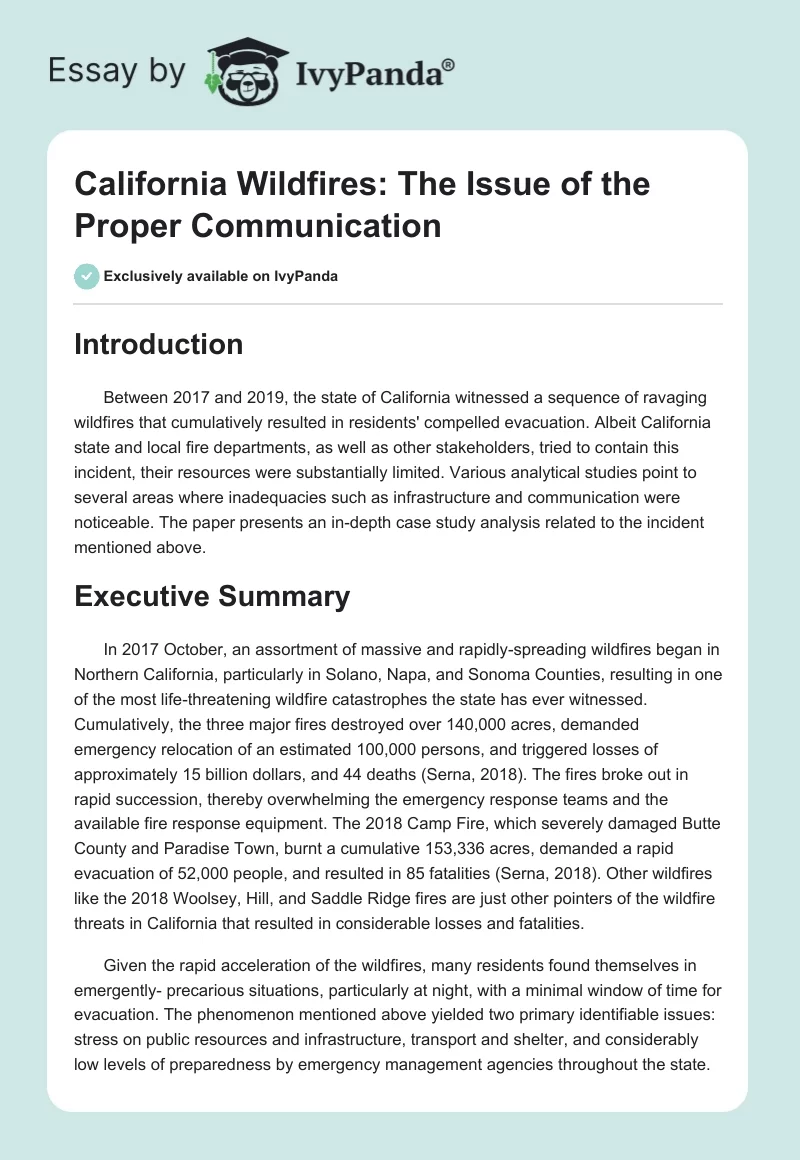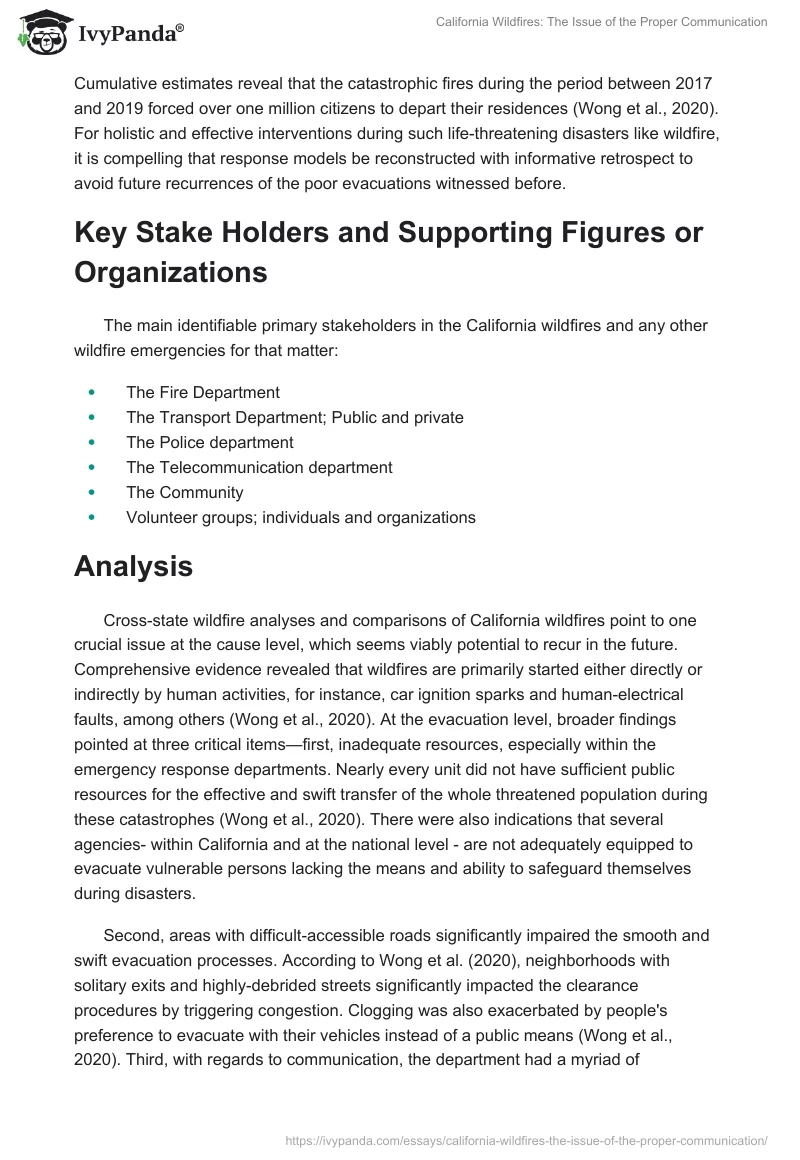Introduction
Between 2017 and 2019, the state of California witnessed a sequence of ravaging wildfires that cumulatively resulted in residents’ compelled evacuation. Albeit California state and local fire departments, as well as other stakeholders, tried to contain this incident, their resources were substantially limited. Various analytical studies point to several areas where inadequacies such as infrastructure and communication were noticeable. The paper presents an in-depth case study analysis related to the incident mentioned above.
Executive Summary
In 2017 October, an assortment of massive and rapidly-spreading wildfires began in Northern California, particularly in Solano, Napa, and Sonoma Counties, resulting in one of the most life-threatening wildfire catastrophes the state has ever witnessed. Cumulatively, the three major fires destroyed over 140,000 acres, demanded emergency relocation of an estimated 100,000 persons, and triggered losses of approximately 15 billion dollars, and 44 deaths (Serna, 2018). The fires broke out in rapid succession, thereby overwhelming the emergency response teams and the available fire response equipment. The 2018 Camp Fire, which severely damaged Butte County and Paradise Town, burnt a cumulative 153,336 acres, demanded a rapid evacuation of 52,000 people, and resulted in 85 fatalities (Serna, 2018). Other wildfires like the 2018 Woolsey, Hill, and Saddle Ridge fires are just other pointers of the wildfire threats in California that resulted in considerable losses and fatalities.
Given the rapid acceleration of the wildfires, many residents found themselves in emergently- precarious situations, particularly at night, with a minimal window of time for evacuation. The phenomenon mentioned above yielded two primary identifiable issues: stress on public resources and infrastructure, transport and shelter, and considerably low levels of preparedness by emergency management agencies throughout the state. Cumulative estimates reveal that the catastrophic fires during the period between 2017 and 2019 forced over one million citizens to depart their residences (Wong et al., 2020). For holistic and effective interventions during such life-threatening disasters like wildfire, it is compelling that response models be reconstructed with informative retrospect to avoid future recurrences of the poor evacuations witnessed before.
Key Stake Holders and Supporting Figures or Organizations
The main identifiable primary stakeholders in the California wildfires and any other wildfire emergencies for that matter:
- The Fire Department
- The Transport Department; Public and private
- The Police department
- The Telecommunication department
- The Community
- Volunteer groups; individuals and organizations
Analysis
Cross-state wildfire analyses and comparisons of California wildfires point to one crucial issue at the cause level, which seems viably potential to recur in the future. Comprehensive evidence revealed that wildfires are primarily started either directly or indirectly by human activities, for instance, car ignition sparks and human-electrical faults, among others (Wong et al., 2020). At the evacuation level, broader findings pointed at three critical items—first, inadequate resources, especially within the emergency response departments. Nearly every unit did not have sufficient public resources for the effective and swift transfer of the whole threatened population during these catastrophes (Wong et al., 2020). There were also indications that several agencies- within California and at the national level – are not adequately equipped to evacuate vulnerable persons lacking the means and ability to safeguard themselves during disasters.
Second, areas with difficult-accessible roads significantly impaired the smooth and swift evacuation processes. According to Wong et al. (2020), neighborhoods with solitary exits and highly-debrided streets significantly impacted the clearance procedures by triggering congestion. Clogging was also exacerbated by people’s preference to evacuate with their vehicles instead of a public means (Wong et al., 2020). Third, with regards to communication, the department had a myriad of alternatives to adopt, albeit not all options were exhausted. The impact was that inadequate communication was substantially witnessed in several Californian wildfires (Wong et al., 2020). A combination of these inefficiencies resulted in substandard evacuation approaches and considerable losses that arguably would have been averted.
Recommendations
Each of the identified stakeholders had an instrumental role in facilitating the swift and effective emergency evacuation during the wildfires to mitigate the total realizable risks from the disaster. However, these responsibilities were not manipulated exhaustively to ensure people’s overall safety. To improve future emergency responses during such calamities, several new models are recommendable. First, the state and local jurisdictions should assess or evaluate the longitudinal impact of historical fires and establish patterns; this will help distinguish the vulnerability of localities, in effect, mark them as vulnerable and deploy significantly adequate emergency resources within convenient vicinities. Cross-state longitudinal evaluations can aid in identifying gaps in infrastructure and other critical items necessary for emergency evacuations.
Second, there is a need to explore the most comprehensive communication media available to the residents. During this era of technological robustness, a myriad of avenues should be available for communication with citizens, especially during emergency disasters. Third, the community should be widely educated on the adverse impacts of wildfires and taught fundamental response measures. During this period of sharing economies, there are many options to address issues like shelter and transport through applications such as Uber and Lyft, or Airbnb. Such items could significantly address the issue of transportation and settlement of evacuated persons.
Conclusion
Wildfires pose a significant threat to the economic welfare and lives of many communities. In particular, California has witnessed severe damages and incurred substantial losses from wildfires, especially between 2017 and 2019. Nonetheless, evidence points to the state’s continued lack of adequate preparedness to combat such recurrent emergencies. In this era of technological advancements, several strategies that aim to facilitate aspects such as proper communication and timely emergency response should be implemented to prevent the adverse impacts of these disasters.
References
Wong, S. D., Broader, J. C., & Shaheen, S. A. (2020). Review of California wildfire evacuations from 2017 to 2019 [PDF document]. UC Office of the President: University of California Institute of Transportation Studies.
Serna, J. (2018). Without warning: Redding fire moved faster than evacuation orders, leaving a deadly toll. Los Angeles Times.


